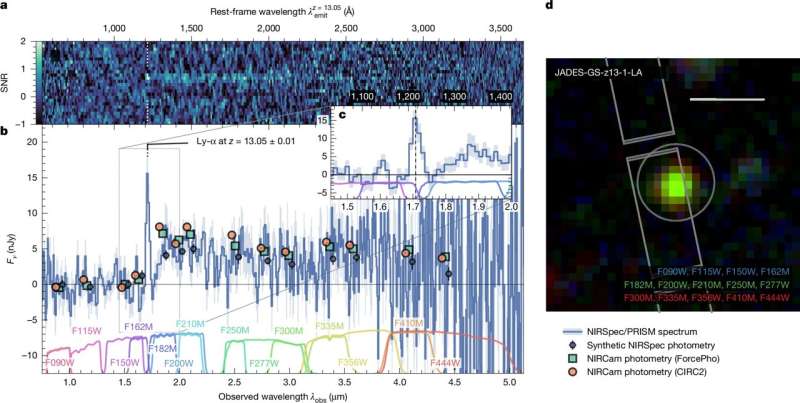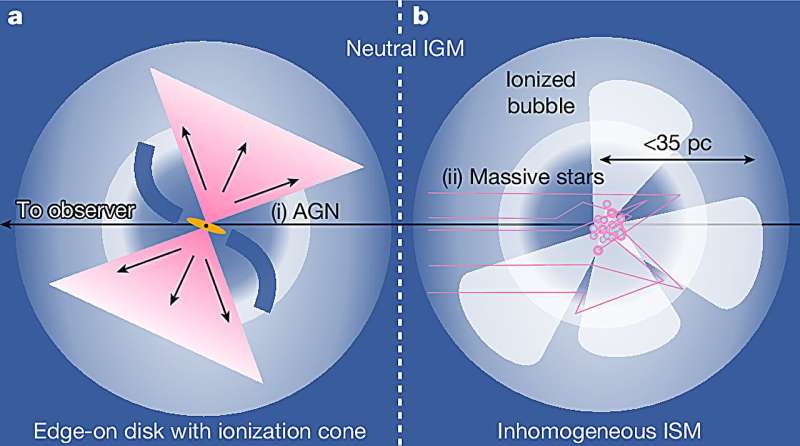Astronomers have identified a bright hydrogen emission from a galaxy in the very early universe. The surprise finding is challenging researchers to explain how this light could have pierced the thick fog of neutral hydrogen that filled space at that time.
A key goal of the NASA/ESA/CSA James Webb Space Telescope has been to see further than ever before into the distant past of our universe, when the first galaxies were forming after the Big Bang, a period known as cosmic dawn.
Researchers studying one of those very early galaxies have now made a discovery in the spectrum of its light, that challenges our established understanding of the universe’s early history. Their results are reported in the journal Nature.
Webb discovered the incredibly distant galaxy JADES-GS-z13-1, observed at just 330 million years after the Big Bang. Researchers used the galaxy’s brightness in different infrared filters to estimate its redshift, which measures a galaxy’s distance from Earth based on how its light has been stretched out during its journey through expanding space.
The NIRCam imaging yielded an initial redshift estimate of 12.9. To confirm its extreme redshift, an international team led by Dr. Joris Witstok, previously of the University of Cambridge’s Kavli Institute for Cosmology, observed the galaxy using Webb’s Near-Infrared Spectrograph (NIRSpec) instrument.

The resulting spectrum confirmed the redshift to be 13.0. This equates to a galaxy seen just 330 million years after the Big Bang, a small fraction of the universe’s present age of 13.8 billion years.
But an unexpected feature also stood out: one specific, distinctly bright wavelength of light, identified as the Lyman-α emission radiated by hydrogen atoms. This emission was far stronger than astronomers thought possible at this early stage in the universe’s development.
“The early universe was bathed in a thick fog of neutral hydrogen,” said co-author Professor Roberto Maiolino from Cambridge’s Kavli Institute for Cosmology. “Most of this haze was lifted in a process called reionization, which was completed about one billion years after the Big Bang.
“GS-z13-1 is seen when the universe was only 330 million years old, yet it shows a surprisingly clear, telltale signature of Lyman-α emission that can only be seen once the surrounding fog has fully lifted. This result was totally unexpected by theories of early galaxy formation and has caught astronomers by surprise.”
Before and during the epoch of reionization, neutral hydrogen fog surrounding galaxies blocked any energetic ultraviolet light they emitted, much like the filtering effect of colored glass. Until enough stars had formed and were able to ionize the hydrogen gas, no such light—including Lyman-α emission—could escape from these fledgling galaxies to reach Earth.

The confirmation of Lyman-α radiation from this galaxy has great implications for our understanding of the early universe. “We really shouldn’t have found a galaxy like this, given our understanding of the way the universe has evolved,” said co-author Kevin Hainline from the University of Arizona.
“We could think of the early universe as shrouded with a thick fog that would make it exceedingly difficult to find even powerful lighthouses peeking through, yet here we see the beam of light from this galaxy piercing the veil.”
The source of the Lyman-α radiation from this galaxy is not yet known, but it may include the first light from the earliest generation of stars to form in the universe.
“The large bubble of ionized hydrogen surrounding this galaxy might have been created by a peculiar population of stars—much more massive, hotter and more luminous than stars formed at later epochs, and possibly representative of the first generation of stars,” said Witstok, who is now based at the Cosmic Dawn Center at the University of Copenhagen. A powerful active galactic nucleus, driven by one of the first supermassive black holes, is another possibility identified by the team.
The team plans further follow-up observations of GS-z13-1, aiming to obtain more information about the nature of this galaxy and origin of its strong Lyman-α radiation. Whatever the galaxy is concealing, it is certain to illuminate a new frontier in cosmology.
More information:
Joris Witstok, Witnessing the onset of reionization through Lyman-α emission at redshift 13, Nature (2025). DOI: 10.1038/s41586-025-08779-5. www.nature.com/articles/s41586-025-08779-5
Citation:
Webb telescope sees galaxy in mysteriously clearing fog of early universe (2025, March 26)
retrieved 27 March 2025
from https://phys.org/news/2025-03-webb-telescope-galaxy-mysteriously-fog.html
This document is subject to copyright. Apart from any fair dealing for the purpose of private study or research, no
part may be reproduced without the written permission. The content is provided for information purposes only.

